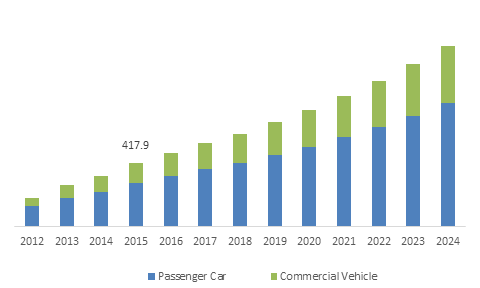U.S. Gasoline Direct Injection System Market to depict a remarkable growth over 2016-2024, strict adherence to regulations regarding fuel emissions to drive the regional growth
Publisher : Fractovia | Published Date : 2017-04-11Request Sample
Gasoline Direct Injection (GDI) System Market is gaining significant traction owing to a strict regulatory framework to reduce GHG emissions and the growing deployment of fuel conservation technologies. Reliable sources state that more than 87 million cars and light commercial vehicles were sold in 2016 alone. Thus, the ever-growing demand for automobiles globally will also push GDI system industry to greater heights. According to Global Market Insights, Inc., “Gasoline direct injection (GDI) system market size is projected to exceed a revenue of USD 10 billion by 2024, with a CAGR estimation of more than 12% over 2016-2024.”
GDI systems help enhance the fuel costs and driving experience, thereby contributing to the reduced pollution and emissions in the atmosphere. This will contribute greatly to the growth of the gasoline direct injection system industry. In addition, the convergence of advanced technologies with automotive components, enhanced vehicle operation, compactness, and high performance in automobiles will ensure an exponential rise in the consumer pool, thereby driving gasoline direct injection system market.
Germany GDI system market size, by application, 2012-2024 (USD Million)

Increased consumer spending and the high global demand for automobiles has led to a significant surge in the sale of passenger cars. Gasoline direct injection system industry from passenger cars application is likely to increase notably over the next seven years, especially across the U.S. and China, which hold the largest passenger car customer pool. High demand for reliable, cost-effective, and enhanced performance commercial vehicles from the transportation and logistics sectors will spur gasoline direct injection system market from commercial vehicles. Having accounted for more than 30% of the total share in 2015, commercial vehicles application is set to grow at a CAGR of more than 12% over 2016-2024.
Geographically, U.S. gasoline direct injection system industry dominated the regional market in 2015, with a contribution of more than 90%, and is anticipated to grow at a CAGR of 13% over the years to come. This regional growth can be credited to the stringent government norms regarding fuel emissions, vehicle standards, and fuel economy. Speaking of fuel-related norms, the European Union has also introduced standards such as Euro 5, regarding the fuel emission rates. Compliance with such strict regulations, huge demand for automobiles, and the advent of innovative fuel-saving technologies will push Europe gasoline direct injection system market over 2016-2024.
Asia Pacific is projected to be the region depicting the maximum growth rate over 2016-2024, which can be credited to increased customer spending, high automobile demand, and government concerns regarding GHG emissions.
Component-wise, GDI industry encompasses sensors, fuel injectors, electronic control units, and fuel pumps. Sensors are practically used for every functionality in automotive systems. Owing to their wide application scope, sensors market will continue to grow lucratively over 2016-2024, having held a contribution of more than 9% of the total share in 2015. Electronic control units contribute to regulated equipment control and improved fuel consumption. GDI industry share from electronic control units will grow at a rapid pace over 2016-2024, having accounted for the highest share of the total revenue in 2015.
Global GDI system market is highly competitive and industry leaders are continuously engaged in growth tactics to sustain their position. Since global automotive industry being highly consolidated, GDI system market players periodically face issues related to pricing and product innovations. Key participants accumulating a major share of gasoline direct injection system industry include Bajaj Auto Ltd., Bosch, Stanadyne, Mitsubishi Electric Corp., Hitachi, MSR Jebsen Technologies, Magneti Marelli, Continental, Eaton Corporation, Denso, and Delphi.